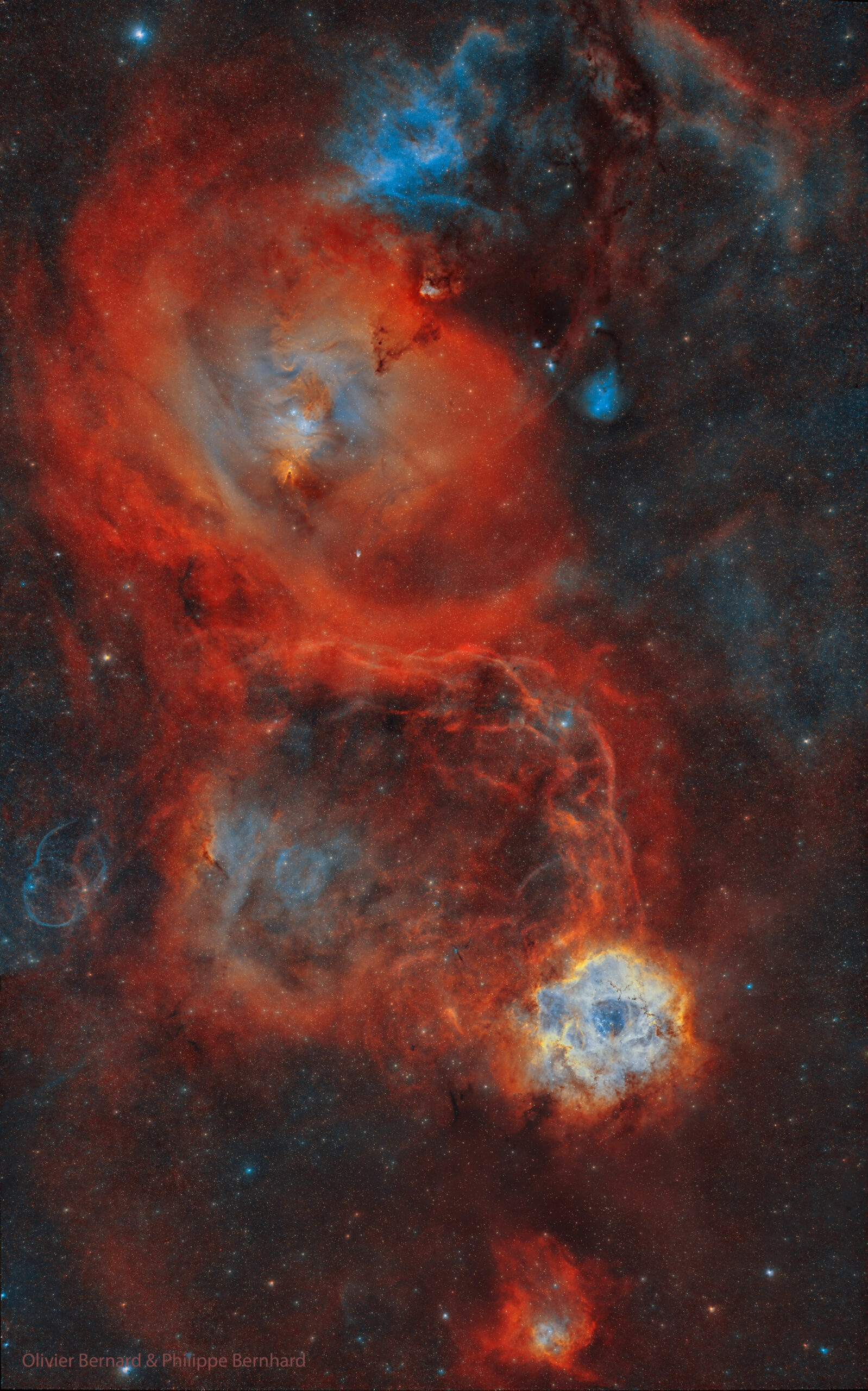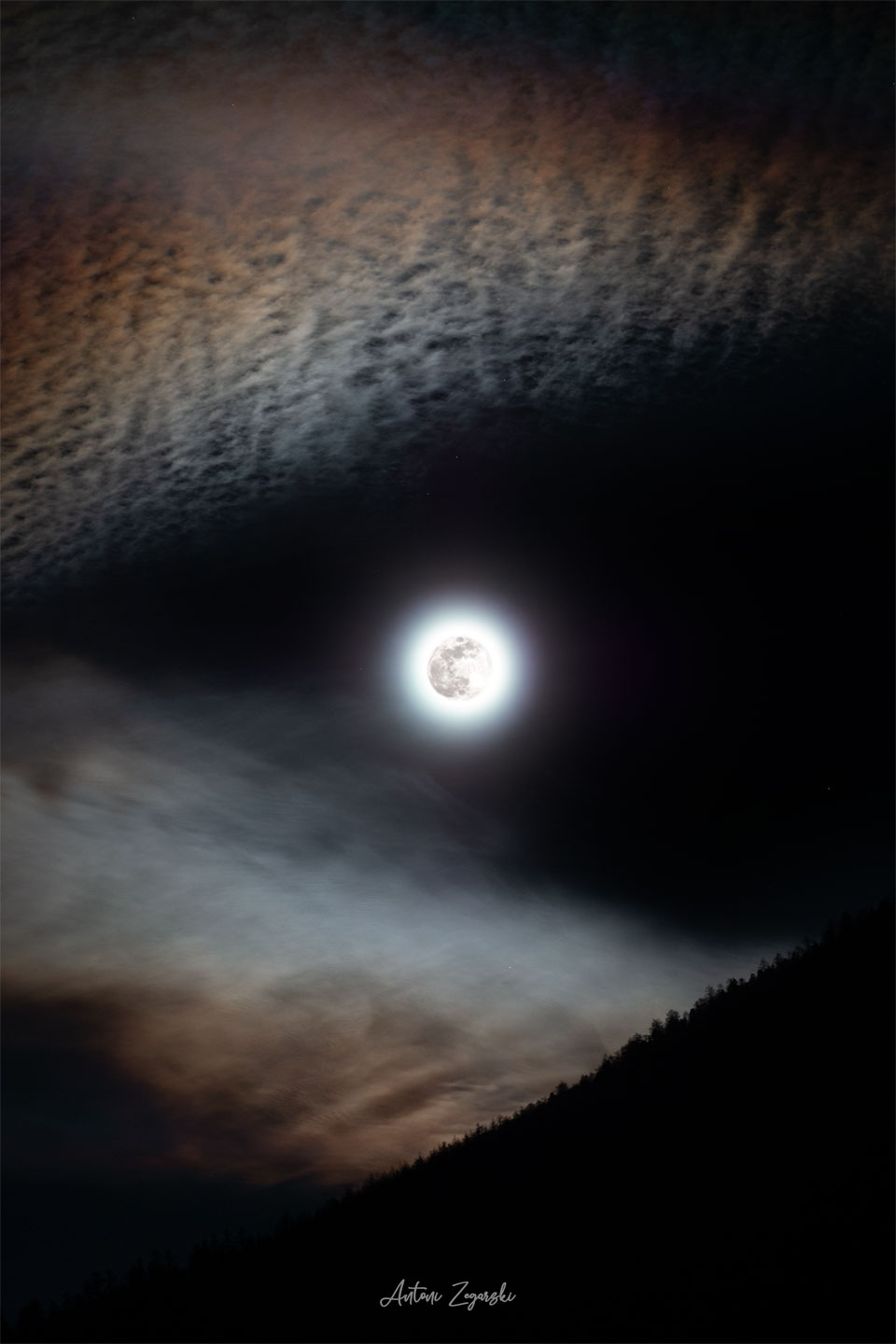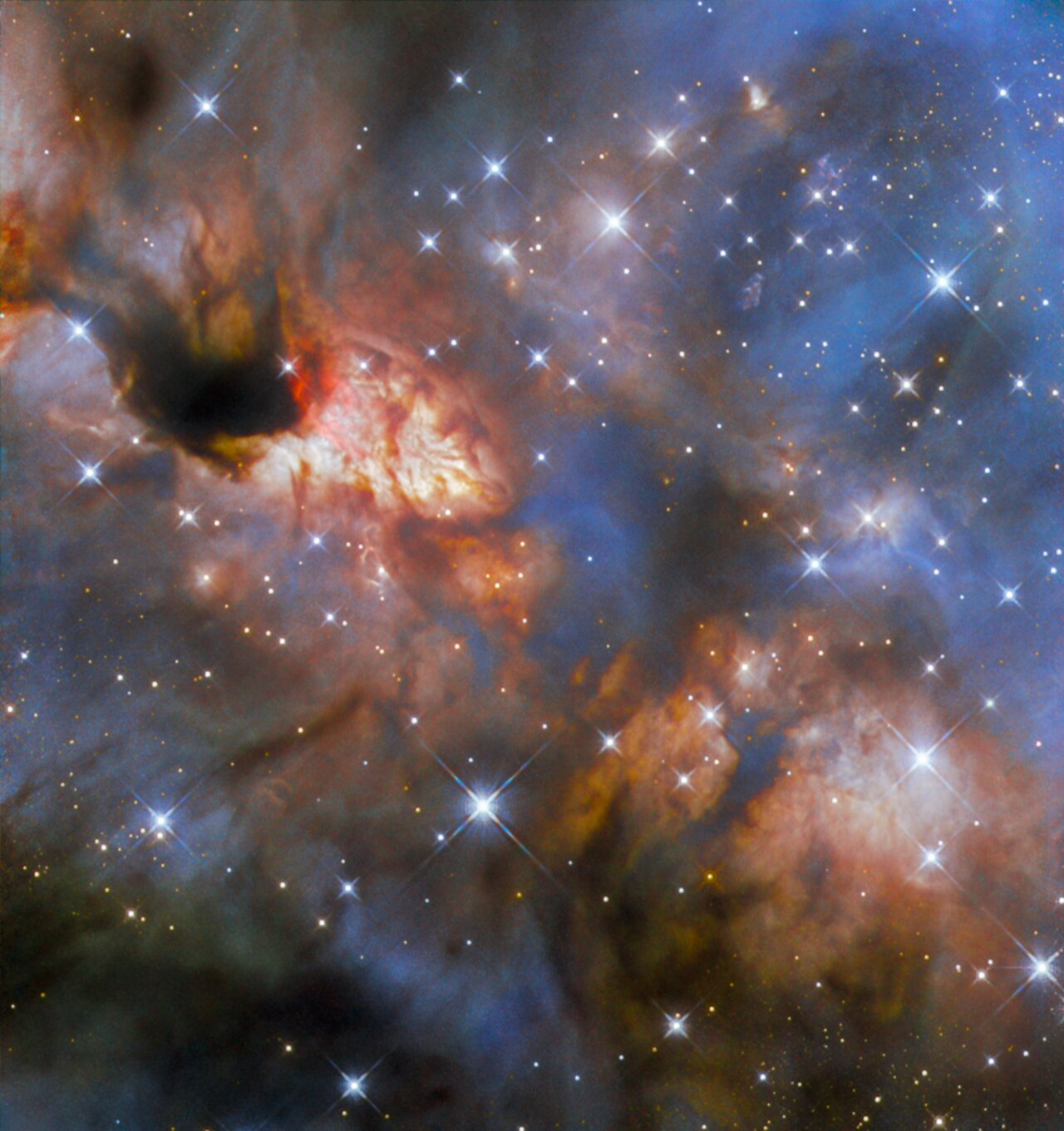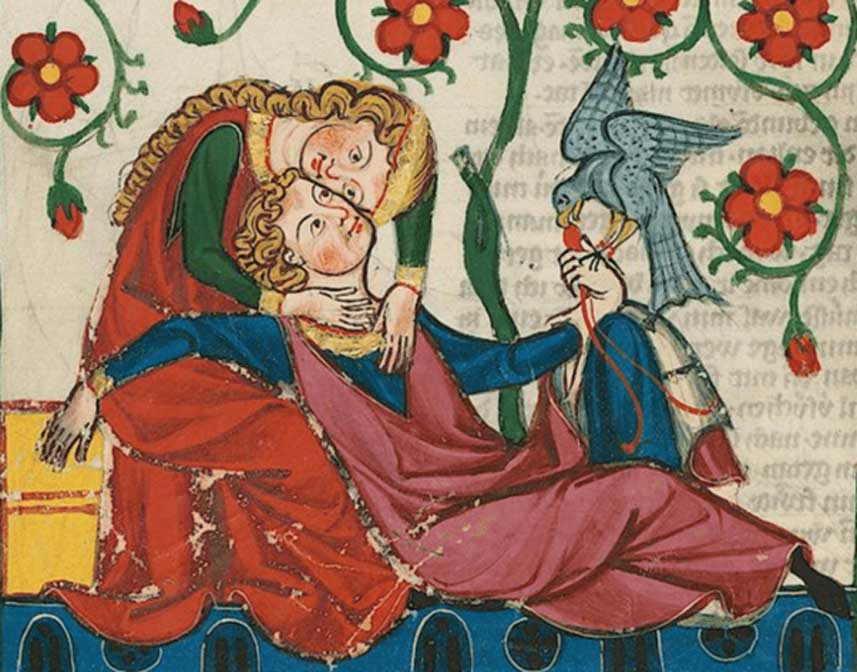Blog
The large, red, and flowery-looking nebula on the upper left may seem the obvious choice, but that is actually just diffuse hydrogen emission surrounding the Cone and Fox Fur Nebulas. The famous Rosette Nebula is really located on the lower right and connected to the other nebulas by irregular filaments. Because the featured image of Rosetta’s field is so wide and deep, it seems to contain other flowers. Designated NGC 2237, the center of the Rosette nebula is populated by the bright blue stars of open cluster NGC 2244, whose winds and energetic light are evacuating the nebula’s center. The Rosette Nebula is about 5,000 light years distant and, just by itself, spans about three times the diameter of a full moon. This flowery field can be found toward the constellation of the Unicorn (Monoceros).
Timothy Charles Buckley III (February 14, 1947 – June 29, 1975) was an American musician. He began his career based in folk rock, but subsequently experimented with genres such as psychedelia, jazz, the avant-garde, and funk as well as unconventional vocal stylings. His commercial peak came with the 1969 album Happy Sad, reaching No. 81 on the charts, while his experimental 1970 album Starsailor went on to become a cult favorite. The latter contained his best known song, “Song to the Siren.” Buckley died at the age of 28 from a heroin and morphineoverdose, leaving behind sons Taylor and Jeff.
Tim Buckley was born in Washington, D.C., on Valentine’s Day, February 14, 1947, to Elaine (née Scalia), an Italian American, and Timothy Charles Buckley Jr., a decorated World War II veteran and son of Irish immigrants from Cork. He spent his early childhood in Amsterdam, New York, an industrial city about 40 miles (64 km) northwest of Albany. At five years old, Buckley began listening to his mother’s progressive jazz recordings, particularly Miles Davis.
more...Merl Saunders (February 14, 1934 – October 24, 2008) was an American multi-genre musician who played piano and keyboards, favoring the Hammond B-3 console organ.
Born in San Mateo, California, United States, Saunders attended Polytechnic High School in San Francisco. In his first band in high school was singer Johnny Mathis. He served in the U.S. Air Force from 1953 to 1957. He worked as musical director of the Billy Williams Revue and served in a similar capacity in Oscar Brown Jr.‘s off-Broadway show, Big Time Buck White.
He gained notice in the 1970s when he began collaborating with Jerry Garcia, with whom he had begun playing in 1971 at a small Fillmore Street nightclub called The Matrix. He sat in with the Grateful Dead, and co-founded the Saunders/Garcia Band which produced three albums, and which became the Legion of Mary, with the addition of Martin Fierro (sax) in 1974. It disbanded the following year, but he and Garcia continued to collaborate in the band Reconstruction during 1979, collaborating with Ed Neumeister(trombone), Gaylord Birch (drums) and John Kahn (bass).
more...amuel Gene Maghett (February 14, 1937 – December 1, 1969), known as Magic Sam, was an American Chicago blues musician. He was born in Grenada County, Mississippi, and learned to play the blues from listening to records by Muddy Waters and Little Walter. After moving to Chicago at the age of 19, he was signed by Cobra Records and became well known as a bluesman after the release of his first record, “All Your Love”, in 1957. He was known for his distinctive tremolo guitar playing.
The stage name Magic Sam was devised by Sam’s bass player and childhood friend Mack Thompson at Sam’s first recording session for Cobra, as an approximation of “Maghett Sam”. The name Sam was using at the time, Good Rocking Sam, was already being used by another artist. His career was cut short when he suddenly died of a heart attack in December 1969. He was 32 years old. Magic Sam was buried in the Restvale Cemetery, in Alsip, Illinois.
more...During every month, on average, a full moon occurs in the skies over planet Earth. This is because the Moon takes a month to complete another orbit around our home planet, goes through all of its phases, and once again has its entire Earth-facing half lit by reflected sunlight. Many indigenous cultures give each full moon a name, and this past full moon’s names include the Ice Moon, the Stay at Home Moon, and the Quiet Moon. Occurring in January on the modern western calendar, several cultures have also named the most recent full moon the Wolf Moon, in honor of the famous howling animal. Featured here above the Italian Alps mountains, this past Wolf Moon was captured in combined long and short exposure images. The image is striking because, to some, the surrounding clouds appear as a wolf’s mouth ready to swallow the Wolf Moon, while others see the Moon as a wolf’s eye.

more...
Peter Brian Gabriel (born 13 February 1950) is an English singer-songwriter and musician. He rose to fame as the original lead singer of the progressive rock band Genesis. After leaving Genesis in 1975, he launched a successful solo career with “Solsbury Hill” as his first single. His fifth studio album, So (1986), is his best-selling release and is certified triple platinum in the UK and five times platinum in the US. The album’s most successful single, “Sledgehammer“, won a record nine MTV Awards at the 1987 MTV Video Music Awards and, according to a report in 2011, it was MTV‘s most played music video of all time.
Gabriel has been a champion of world music for much of his career. He co-founded the WOMAD festival in 1982. He has continued to focus on producing and promoting world music through his Real World Records label. He has pioneered digital distribution methods for music, co-founding OD2, one of the first online music download services. Gabriel has also been involved in numerous humanitarian efforts. In 1980, he released the anti-apartheid single “Biko“. He has participated in several human-rights benefit concerts, including Amnesty International‘s Human Rights Now! tour in 1988, and co-founded the Witnesshuman rights organisation in 1992. Gabriel developed The Elders with Richard Branson, which was launched by Nelson Mandela in 2007.
more...King Floyd (February 13, 1945 – March 6, 2006) was a New Orleans soul singer, best known for his top 10 hit from 1970, “Groove Me“.
King Floyd III was born in New Orleans in 1945. His musical career started as a singer at the Sho-Bar on Bourbon Street. Following a stint in the army, Floyd went to California, where he joined up with record producer Harold Battiste. His debut album, A Man in Love, featuring songs co-written with Dr. John, failed to make an impact on the charts. Floyd returned to New Orleans in 1969 and worked for the Post Office.
more...Wardell Gray (February 13, 1921 – May 25, 1955) was an American jazz tenor saxophonist who straddled the swing and bebop periods.
The youngest of four children, Gray was born in Oklahoma City. He spent his early childhood years in Oklahoma before he and his family moved to Detroit in 1929. Gray was still working regularly despite his drug problems, and when Benny Carter was engaged in May 1955 to provide the band at the opening of the Moulin Rouge Hotel, he called on Gray. Gray attended rehearsals but was absent when the club opened on May 25. The next day he was found on a stretch of desert on the outskirts of Las Vegas dead with a broken neck. At the age of 34, he died of a heroin overdose.
more...Only one more day until Mardi Gras Day 2024
more...Teaching a Rhythm Roots Residency at Saint Therese Woodbury starting Monday February 12th 2024 2-330pm for nine weeks. Teaching cultural rhythms to the Senior community for healing and memory care.

If the Hubble Picture of the Week from two weeks ago was somewhat dim and subtle in appearance, then this week’s image is a veritable riot of colour and activity! It features a relatively close-by star-forming region known as IRAS 16562-3959 that lies within the Milky Way in the constellation Scorpius, about 5900 light-years from Earth.
This image was compiled using observations from Hubble’s Wide Field Camera 3 (WFC 3). The detailed nuances of colour are possible because of the four separate filters that were used to collect the data. Filters are thin slivers of highly specialised material that only allow very specific wavelengths of light through. They can be slid in front of the part of the telescope that is sensitive to light, letting astronomers control which wavelengths of light the telescope collects with each observation. This is useful not only for specific scientific research, but also for the creation of images like this one.
Raw telescope observations are always monochrome, regardless of which filter was used. However, specially trained artists and image specialists can select colours that match the wavelength range covered by individual filters. Or, in the case where a direct match is not possible — such as for the data used in this image, which are all in the infrared regime, which human eyes are not sensitive to — the artist can select a colour that sensibly represents what is taking place. For example, they might assign bluer colours to shorter wavelengths and redder colours to longer wavelengths, as is the case in the visible light range. Then, data from multiple filters can be combined to build up a multi-colour image, that both looks beautiful and has scientific meaning.
At the centre of the image, IRAS 16562-3959 is thought to host a massive star — about 30 times the mass of our Sun — that is still in the process of forming. At the near-infrared wavelengths to which Hubble is sensitive, the central region appears dark because there is so much obscuring dust in the way. However near-infrared light leaks out mainly on two sides — upper left and lower right — where a powerful jet from the massive protostar has cleared away the dust. Multi-wavelength images including this incredible Hubble scene will help us gain a better understanding of how the most massive, brightest stars in our galaxy are born.
[Image Description: A nebula with stars. The centre of the image from top-left to bottom-right glows brightly with light from where new stars are being formed, and is partially covered by dark dust. Coloured layers of gas and dust billow out across the rest of the image. The nebula is speckled with foreground stars with large diffraction spikes.]

Omar Hakim (born February 12, 1959) is an American drummer, producer, arranger and composer. His session work covers jazz, jazz fusion, and pop music. He has worked with Weather Report, David Bowie, Foo Fighters, Chic, Sting, Madonna, Dire Straits, Bryan Ferry, Journey, Kate Bush, George Benson, Miles Davis, Daft Punk, Mariah Carey, The Pussycat Dolls, David Lee Roth, and Celine Dion.
Hakim was born in New York City on February 12, 1959. His father, Hasaan Hakim, was a trombonist. Omar started playing the drums at the age of five, and first performed in his father’s band four or five years later.
more...William Otis Laswell (born February 12, 1955 Salem, Ill) is an American bass guitarist, record producer, and record label owner. He has been involved in thousands of recordings with many collaborators from all over the world. His music draws from funk, world music, jazz, dub, and ambient styles.
According to music critic Chris Brazier, “Laswell’s pet concept is ‘collision music’ which involves bringing together musicians from wildly divergent but complementary spheres and seeing what comes out.”Although his bands may be credited under the same name and often feature the same roster of musicians, the styles and themes explored on different albums can vary dramatically. Material began as a noisy dance music band, but later albums concentrated on hip hop, jazz, or spoken word readings by William S. Burroughs. Most versions of the band Praxis have included guitarist Buckethead, but they have explored different permutations on albums.
more...More Posts
- World Music with Obo Addy
- Daily Roots with Bob Marley
- The Cosmos with Fleming 1
- Ernest Ranglin Day
- Billy Drummond Day
- World Music with Lela Tataraidze
- Daily Roots with the Skatalites
- The Cosmos with NGC 6872 & IC 4970
- Paul McCartney Day
- William Hooker Day
- Rudy Rutherford Day
- World Fusion with Manika Kaur
- Daily Roots with the Congos
- Happy Fathers Day 2018
- The Cosmos with RCW 108
- Chuck Rainey Day
- Sing Miller Day
- World Music with Corvus Corax
- Daily Roots with ITSJAHMIEL
- The Cosmos with NGC 3372
